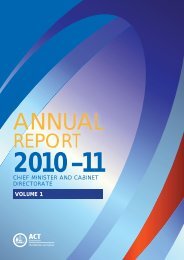OH&S Risk Management Policy ACTPS.pdf - ACT Government
OH&S Risk Management Policy ACTPS.pdf - ACT Government
OH&S Risk Management Policy ACTPS.pdf - ACT Government
You also want an ePaper? Increase the reach of your titles
YUMPU automatically turns print PDFs into web optimized ePapers that Google loves.
_________________________________________________________________________________<br />
<strong>ACT</strong> Public Service<br />
Injury Prevention <strong>Management</strong> <strong>Policy</strong><br />
____________________________________________________________________<br />
<strong>Policy</strong> No<br />
Date of Issue<br />
Application<br />
Contents<br />
Attachments<br />
<strong>Policy</strong><br />
Statement<br />
OHS RISK MANAGEMENT<br />
<strong><strong>ACT</strong>PS</strong>-IPM-POL-008<br />
Text<br />
All <strong><strong>ACT</strong>PS</strong> Agencies<br />
1. Introduction<br />
2. Purpose<br />
3. Objectives<br />
4. Scope<br />
5. Definitions<br />
6. Responsibilities<br />
7. <strong>Risk</strong> <strong>Management</strong> Framework<br />
8. Communicate and Consult<br />
9. Establish the Context<br />
10. Identify Hazards and <strong>Risk</strong>s<br />
11. Analyse and Evaluate <strong>Risk</strong>s<br />
12. Hazard Control<br />
13. Documentation and Review<br />
14. Common Pitfalls in <strong>Risk</strong> <strong>Management</strong><br />
15. References<br />
16. Approving Authority and Review Date<br />
A1. Sample Workplace Inspection Checklist<br />
A2. <strong>Risk</strong> Report Form<br />
A3. <strong>Risk</strong> Assessment Table<br />
A4. <strong>Risk</strong> Treatment and Action Plan<br />
A5. Common Pitfalls in <strong>Risk</strong> Assessment<br />
The <strong>ACT</strong> <strong>Government</strong> recognises that employers have a<br />
responsibility to provide a safe and healthy workplace for employees.<br />
Agencies are required to be proactive in developing and<br />
implementing a risk management framework to identify hazards and<br />
assess risks with the aim of eliminating or reducing their impact in the<br />
workplace.<br />
Signed and authorised by ………………………………………………………………<br />
Cheryl Vardon, Commissioner for Public Administration
Injury Prevention and <strong>Management</strong> <strong>Policy</strong><br />
RISK MANAGEMENT<br />
1. INTRODUCTION<br />
The <strong>ACT</strong> <strong>Government</strong> is committed to providing a safe and healthy working<br />
environment for its employees, contractors and visitors. The <strong>ACT</strong> <strong>Government</strong> has a<br />
commitment to a whole of <strong>Government</strong> <strong>Risk</strong> <strong>Management</strong> Framework that is detailed<br />
at the <strong>ACT</strong> Insurance Agency Website at:<br />
http://www.treasury.act.gov.au/actia/<strong>Risk</strong>.htm. The Australia/New Zealand Standard<br />
for <strong>Risk</strong> <strong>Management</strong> (AS/NZS 4360:2004) informs this framework.<br />
As part of the Safety <strong>Management</strong> System’s approach to Occupational Health and<br />
Safety (OHS), agencies are also required to have a comprehensive risk management<br />
framework to identify risks and to eliminate or reduce their impact in the workplace.<br />
A suitable and thorough risk assessment that is adapted to suit the workplace and with<br />
effective use of the findings, is considered to be an integral part of successful health<br />
and safety management.<br />
2. PURPOSE<br />
The <strong>ACT</strong> <strong>Government</strong> and its employees are accountable under the Occupational<br />
Health and Safety Act 1989 (OHS Act), as modified by the Public Sector<br />
<strong>Management</strong> Act 1994 (PSM Act), for the provision of a safe working environment<br />
including the elimination of hazards in the workplace and taking reasonable steps to<br />
ensure that all employees are in a fit state to work. It is considered that the most<br />
effective and efficient way to create and maintain a healthy and safe work<br />
environment is for <strong>ACT</strong> Public Sector managers to integrate OHS <strong>Risk</strong> <strong>Management</strong><br />
into their daily business operations.<br />
This policy provides advice and guidelines on the implementation of the <strong>Risk</strong><br />
<strong>Management</strong> framework to occupational health and safety in the work environment.<br />
3. OBJECTIVES<br />
This policy aims to provide guidance to employers and employees to:<br />
• develop a framework for the identification of hazards, assessment of risks and<br />
the reduction and/or elimination of risks<br />
• implement processes to ensure that all reasonable steps are taken to safeguard<br />
the health and safety at work<br />
• implement a continuous review process as part of the Safety <strong>Management</strong><br />
System for their agency.<br />
4. SCOPE<br />
This policy shall apply to all Act Public Sector (<strong><strong>ACT</strong>PS</strong>) employees and 3rd parties.<br />
INJURY PREVENTION AND MANAGEMENT<br />
OH&S RISK MANAGEMENT POLICY <strong><strong>ACT</strong>PS</strong>-IPM-POL-008<br />
NOVEMBER 2005 2 OF 22
5. DEFINITIONS<br />
<strong>Risk</strong> management – the culture, processes and structures that are directed towards<br />
realising potential opportunities whilst managing adverse effects. 1<br />
Hazard – a source of potential harm. 2 . A source or a situation with a potential for<br />
harm in terms of human injury or ill health, damage to property, damage to the<br />
environment, or a combination of these. 3<br />
<strong>Risk</strong> – the chance of something happening that will have an impact upon objectives.<br />
<strong>Risk</strong> is often specified in terms of an event or circumstance and the consequences that<br />
may flow from it. <strong>Risk</strong> is measured in terms of a combination of the consequences of<br />
an event and their likelihood. <strong>Risk</strong> may have a positive or negative impact. 4<br />
OHS <strong>Risk</strong> – (in relation to any potential injury or harm) the likelihood and<br />
consequence of that injury or harm occurring. 5<br />
Exposure occurs when a person comes into contact with a hazard.<br />
Control Measures are actions that are taken to control hazards and reduce risks.<br />
Hierarchy of Controls is the preferred order of control measures<br />
Employee – means the employees of the <strong><strong>ACT</strong>PS</strong> (as defined in the PSM Act), and<br />
contractors, sub-contractors and consultants employed by <strong><strong>ACT</strong>PS</strong> agencies, whilst<br />
they are on <strong>ACT</strong> <strong>Government</strong> property or engaged on <strong>ACT</strong> <strong>Government</strong> business.<br />
6. RESPONSIBILITIES<br />
6.1 Senior <strong>Management</strong><br />
For an OHS <strong>Risk</strong> <strong>Management</strong> strategy to be successful in an agency, it must be<br />
driven from senior management level, as this is the management level responsible for<br />
making critical decisions in terms of future direction. <strong>Risk</strong> <strong>Management</strong> should be<br />
integrated during the initial stages of business planning.<br />
Within this context, human and financial resources should be made available for:<br />
• training and education of staff and line managers in hazard identification, risk<br />
assessment and risk management<br />
• allocation of funds for purchase of appropriate safety equipment as required<br />
• any workplace modifications, either physical or process changes, which are<br />
required as a result of a risk assessment.<br />
1 AS/NZS 4360<br />
2 AS/NZS4360<br />
3 AS/NZS 4804<br />
4 AS/NZS 4360<br />
5 AS/NZS 4804<br />
INJURY PREVENTION AND MANAGEMENT<br />
OH&S RISK MANAGEMENT POLICY <strong><strong>ACT</strong>PS</strong>-IPM-POL-008<br />
NOVEMBER 2005 3 OF 22
6.2 Line Managers<br />
Line managers and supervisors have a responsibility and duty of care to their staff.<br />
They are responsible for:<br />
• implementing a comprehensive and regular inspection process for hazard<br />
identification in the workplace<br />
• ensuring that risk assessments are conducted for identified hazards<br />
• implementing, monitoring and maintaining risk control measures as<br />
recommended in the <strong>Risk</strong> <strong>Management</strong> Assessment<br />
• maintaining good communication between management, staff and relevant<br />
unions<br />
• working co-operatively with Injury Prevention and <strong>Management</strong> personnel<br />
and all stakeholders to develop strategies that improve workplace safety<br />
culture<br />
• reviewing the effectiveness of hazard control measures.<br />
6.3 Employees<br />
All employees have a responsibility to :<br />
• assist line managers with the identification of hazards, the assessment of risks<br />
and the implementation of risk control measures<br />
• report the occurrence of any incident/accident or near miss to their<br />
supervisor/line manager or the OHS Unit<br />
• comply with all safety procedures and directions related to their workplace.<br />
7. RISK MANAGEMENT FRAMEWORK<br />
The <strong>Risk</strong> <strong>Management</strong> Framework is detailed on the <strong>ACT</strong> Insurance Agency<br />
(<strong>ACT</strong>IA) Website at http://www.treasury.act.gov.au/actia/<strong>Risk</strong>.htm. This site<br />
provides comprehensive guidance material on the development and implementation of<br />
a risk management framework for your agency.<br />
Reference should also be made to the Standards Australia OHS <strong>Risk</strong> <strong>Management</strong><br />
Handbook HB 205-2004. (A copy of this publication can be requested from the<br />
Legislative Assembly Library.)<br />
8. COMMUNICATE AND CONSULT<br />
Staff experienced in the history of workplace incidents can provide valuable expertise<br />
in hazard identification and the identification of potentially recurring risks.<br />
An atmosphere should be established in which employees feel confident to bring<br />
managers’ attention to any occupational health and safety concerns that they may<br />
have. The response to reports of hazards should be positive and timely, with effective<br />
follow-up.<br />
Arrangements should be made to regularly consult with staff to find out what health<br />
and safety issues they may have in their work and seek suggestions for improvements.<br />
INJURY PREVENTION AND MANAGEMENT<br />
OH&S RISK MANAGEMENT POLICY <strong><strong>ACT</strong>PS</strong>-IPM-POL-008<br />
NOVEMBER 2005 4 OF 22
The processes used to establish the context, identify, analyse, evaluate, treat and<br />
monitor and review risks must be systematic and involve consultation with<br />
employees, contractors and other stakeholders so that everyone has confidence in the<br />
outcomes.<br />
9. ESTABLISH THE CONTEXT<br />
The first step in managing risk is to gather background information about the<br />
organization as a whole. This includes identifying the external, internal and risk<br />
management issues and establishes a context within which OHS risks are to be<br />
managed as outlined in the following table.<br />
External Context<br />
Internal Context<br />
<strong>Risk</strong> <strong>Management</strong> Context<br />
Define the external environment in which the<br />
organization operates. Determine the key business<br />
drivers and the values of stakeholders.<br />
It is important to understand the operations of the<br />
organization. Key areas include: culture, internal<br />
stakeholders, resource base, the goals and objectives<br />
as well as the strategies in place to achieve them.<br />
Identify the goals, objectives, strategies, scope and<br />
parameters of the activity or part of the organization<br />
to which the risk management process is to be<br />
applied.<br />
10. IDENTIFY HAZARDS AND RISKS<br />
Hazard identification is the process of finding all items, activities and situations,<br />
products and services, that could give rise to injury or illness. Hazards should be<br />
recognised. This is an ongoing responsibility, as new processes and materials are<br />
introduced to the workplace, the types of hazards to which employees are exposed,<br />
may change.<br />
Some hazards, such as unguarded power saw blades or toxic chemicals, may be<br />
obvious. However there can be other hazards, such as manual handling practices,<br />
violence/aggression and repetitive tasks that may not be so easily identified.<br />
Some methods of hazard identification include:<br />
• consultation with employees<br />
• specific health and safety issues raised by employees/unions<br />
• workplace inspections<br />
• material safety data sheets and chemical labels<br />
• investigating accidents and near misses<br />
• examining accident, leave and workers’ compensation records to identify<br />
trends.<br />
Consideration should be given to:<br />
a) the type of injury or illness that is possible<br />
INJURY PREVENTION AND MANAGEMENT<br />
OH&S RISK MANAGEMENT POLICY <strong><strong>ACT</strong>PS</strong>-IPM-POL-008<br />
NOVEMBER 2005 5 OF 22
) the situations or events, or combination of circumstances, that could<br />
give rise to injury or incident<br />
c) the way work is organized and managed.<br />
It is important to identify both the hazards and how the hazards represent a risk to<br />
health and safety.<br />
10.1 Workplace Inspections<br />
The local manager and health and safety representatives must arrange a program of<br />
regular inspections of the work area with the aim of identifying hazards that may be<br />
overlooked in the general course of day to day events.<br />
The physical inspection of the work area should include the following aspects:<br />
• workplace environment and design<br />
• systems of work<br />
• employee behaviour<br />
• management commitment to health and safety<br />
• identification of unsafe conditions and practices<br />
• checking of new facilities, equipment, or processes<br />
• adherence to safety procedures and standards<br />
• customer demand and external pressures.<br />
An Inspection Checklist is to be developed for the local work area to facilitate the<br />
inspection. A sample generic checklist is at Attachment 1.<br />
Please note that an inspection that only identifies visible hazards is not sufficient<br />
to meet the guidelines for effective risk management.<br />
10.2 Frequency of Inspections<br />
It is a requirement that all work areas conduct regular hazard inspections. The level of<br />
risk in the workplace must determine the frequency of these inspections. In some<br />
areas, such as an office environment, it may be sufficient to conduct a hazard<br />
inspection every 3 to 6 months unless there have been changes to the work area. In<br />
other environments it may be necessary to conduct hazard checks daily. <strong>Management</strong><br />
of individual <strong>ACT</strong> Public Sector agencies must ensure that their hazard identification<br />
systems meet the requirements of local work areas. Directors/Managers may<br />
designate that a particular work area, task or procedure can be subject to a more<br />
regular assessment. (eg. areas working with hazardous substances or tasks requiring<br />
work in confined spaces.)<br />
10.3 Record Review<br />
Under the OHS Act (as modified) each agency is required to monitor employee health<br />
and safety, keep records and provide appropriate medical and first aid services. An<br />
examination of these records may show trends and indicate areas of concern. Other<br />
sources of information can include such records as: health surveys; monitoring the<br />
level or concentration of a hazard (such as noise, temperature, lighting, fumes, dust or<br />
radiation); advice from expert consultants; codes of practice and material safety data<br />
sheets.<br />
INJURY PREVENTION AND MANAGEMENT<br />
OH&S RISK MANAGEMENT POLICY <strong><strong>ACT</strong>PS</strong>-IPM-POL-008<br />
NOVEMBER 2005 6 OF 22
11. ANALYSE AND EVALUATE RISKS<br />
<strong>Risk</strong> analysis is about developing an understanding of the risk. It provides an input to<br />
decisions on whether risks need to be treated and the most appropriate and costeffective<br />
risk treatment strategies. <strong>Risk</strong> analysis involves consideration of the hazards<br />
and sources of risk, their positive and negative consequences and the likelihood that<br />
those consequences may occur. Factors which affect consequences and likelihood<br />
may be identified. 6<br />
OHS risk analysis assists in the understanding of hazards and risks so that decisions<br />
can be made about whether further treatment or controls are required. The analysis<br />
may be used to assist with a ranking process to decide priorities and draw attention to<br />
high risks.<br />
In determining the level (or severity) of risk, a consideration of the following is<br />
required:<br />
CONSEQUENCE – for each hazard, ask what is the worst likely outcome from<br />
exposure to the hazard (eg catastrophic, major, moderate, minor or insignificant).<br />
EXPOSURE – how many people are exposed to the hazard and for how long This<br />
needs to be considered when setting priorities for implementing controls.<br />
LIKELIHOOD – what is the likelihood of harm occurring if the person is exposed to<br />
the hazard This could range from almost certain to rare.<br />
All hazards should be reported in a <strong>Risk</strong> Assessment Report (Attachment 2) and the<br />
level of risk evaluated.<br />
One method of evaluating risks is to use a <strong>Risk</strong> Assessment Table. (Attachment 3)<br />
Record the risk rating for each identified hazard. <strong>Risk</strong>s with EXTREME and HIGH<br />
ratings must be addressed first.<br />
The purpose of risk evaluation is to make decisions, based on the outcomes of risk<br />
analysis, about which risks need treatment and treatment priorities. Once risks have<br />
been identified and assessed, action must be taken to control them.<br />
12. HAZARD CONTROL<br />
There is a preferred order in which risks should be controlled. This is called the<br />
hierarchy of controls:<br />
1. Eliminating the hazard from the workplace entirely is the best way to control<br />
it. However this may not always be possible and other strategies may be<br />
necessary.<br />
2. Substituting or modifying the hazard by replacing it with something less<br />
dangerous. (eg using different, safer equipment)<br />
3. Isolating the hazard by physically removing it from the workplace or by<br />
cordoning off the area in which a machine is used.<br />
4. Engineering methods can be introduced to control the hazard at its source,<br />
tools and equipment can be redesigned, enclosures built, guards or local<br />
exhaust ventilation systems can be installed.<br />
6 AS/NZS 4360<br />
INJURY PREVENTION AND MANAGEMENT<br />
OH&S RISK MANAGEMENT POLICY <strong><strong>ACT</strong>PS</strong>-IPM-POL-008<br />
NOVEMBER 2005 7 OF 22
Backup Controls<br />
5. Administrative controls are the management strategies, which can be<br />
introduced to ensure the health and safety of employees. Administrative<br />
procedures can reduce exposure to hazardous equipment and processes by<br />
limiting the time of exposure (eg job rotation) or varying the time when a<br />
particular process is carried out. The way in which processes are carried out<br />
can also be redesigned or re-organised. Administrative controls rely on<br />
appropriate human behaviour to be effective so staff training and safe working<br />
procedures are important.<br />
6. Personal protective equipment (PPE) may also be used to reduce exposure to<br />
a hazard.<br />
Back-up controls should underpin the other control measures and can also be<br />
implemented as an initial response while assessing the risks in the workplace and<br />
developing a <strong>Risk</strong> Treatment and Action Plan (Attachment 4).<br />
It may be necessary to implement a combination of controls in order to reduce the<br />
level of risk.<br />
12.1 Monitoring Controls.<br />
Control measures must be monitored to ensure the effectiveness of the corrective<br />
action. For each control decide:<br />
• How do you know whether it is effective in preventing harm<br />
• How can this be checked and tested<br />
• How often should this testing be done<br />
• Who is best qualified to do the checking<br />
13. DOCUMENTATION AND REVIEW<br />
The hazard identification, risk assessment and the control measures must be<br />
documented for action by management and all staff. The report must also include a<br />
mechanism to ensure that the findings are acted upon and that there is a system for<br />
regular review of the assessment.<br />
<strong>Risk</strong> assessment should not be a one off activity, but should be ongoing and be part of<br />
the process of continuous improvement. <strong>Risk</strong> assessments should be reviewed as part<br />
of standard safety management practice. They should also be reviewed if there is a<br />
reason to suspect that the findings are no longer appropriate or valid. (For example,<br />
after an accident, incident or near miss or when there is a change in the work process<br />
or significant new information or techniques become available)<br />
All OH & S <strong>Risk</strong> <strong>Management</strong> Reports are to be :<br />
• referred to area managers for action<br />
• tabled at workplace OH & S Committee meetings as part of an effective Safety<br />
<strong>Management</strong> System<br />
• available to all staff who work in the relevant area<br />
• regularly reviewed and modified as necessary.<br />
INJURY PREVENTION AND MANAGEMENT<br />
OH&S RISK MANAGEMENT POLICY <strong><strong>ACT</strong>PS</strong>-IPM-POL-008<br />
NOVEMBER 2005 8 OF 22
14. COMMON PITFALLS IN RISK ASSESSMENT<br />
Staff engaged in assessing risks should be aware of the common mistakes that can be<br />
made in the process, which may lead to incorrect assessments. A list of the more<br />
common pitfalls has been outlined in Attachment 5.<br />
15. REFERENCES<br />
• <strong>ACT</strong> Occupational Health and Safety Act 1989 (OHS Act), as modified by the<br />
PSM Act<br />
• Public Sector <strong>Management</strong> Act 1994 (PSM Act)<br />
• Australian/ New Zealand Standard (AS/NZS 4804:2001) <strong>Management</strong> Systems<br />
–General Guidelines on Principles, Systems, and Supporting Techniques<br />
• Standards Australia OHS <strong>Risk</strong> <strong>Management</strong> Handbook HB 205-2004<br />
• Australian Standard (AS 4801-2000) <strong>Management</strong> Systems – Specifications<br />
and Guidance<br />
• Australian/New Zealand Standard (AS/NZS 4360:2004) – <strong>Risk</strong> <strong>Management</strong><br />
and accompanying guidelines HB436:2004<br />
• <strong><strong>ACT</strong>PS</strong> agency Certified Agreement(s) 2004-2007<br />
• Safety <strong>Management</strong> System <strong>Policy</strong> – (draft)<br />
• Safety, Rehabilitation and Compensation (SRC) Commission <strong>Risk</strong><br />
<strong>Management</strong> Model.<br />
• <strong>Risk</strong> <strong>Management</strong> Guide and Toolkit developed by <strong>ACT</strong> Insurance Authority<br />
16. APPROVING AUTHORITY AND REVIEW DATE<br />
This policy will be reviewed within 3 years from the date of approval, being on<br />
…./ …. / …..<br />
………………………………………….<br />
Commissioner for Public Administration<br />
…………………<br />
Date<br />
Feedback and advice on policy directions can be forwarded to<br />
IPM.<strong>Policy</strong>feedback@act.gov.au<br />
INJURY PREVENTION AND MANAGEMENT<br />
OH&S RISK MANAGEMENT POLICY <strong><strong>ACT</strong>PS</strong>-IPM-POL-008<br />
NOVEMBER 2005 9 OF 22
ATTACHMENT 1<br />
SAMPLE WORKPLACE INSPECTION CHECKLIST<br />
Area ………………………………………………………………………………….…………<br />
Date of Inspection:…………………<br />
Inspected by:………………………………<br />
Floors/Stairs/Passageways<br />
Floors/stairs have an even<br />
surface<br />
Stable non-slip floor coverings<br />
Walkways adequately lit<br />
Electrical leads crossing<br />
walkways<br />
Entry/egress points kept clear<br />
Handrails in good repair<br />
Changes of level obvious<br />
General Lighting<br />
Adequate illumination levels<br />
Good natural lighting<br />
Good light reflection from walls<br />
and ceiling<br />
Any direct or reflected glare<br />
Light fittings clean and in good<br />
repair<br />
Emergency lighting operable<br />
Hazard<br />
Y/N<br />
<strong>Risk</strong><br />
Reference<br />
Comments<br />
Additional Comments:<br />
FINAL DRAFT OHS RISK MANAGEMENT POLICY<br />
AUGUST 2005<br />
Page 10 of 22
ATTACHMENT 1<br />
SAMPLE WORKPLACE INSPECTION CHECKLIST<br />
Area ………………………………………………………………………………….…………<br />
Office Furniture/Equipment<br />
Any sharp edges to tables & desks<br />
Chairs stable and in good repair<br />
Filing cabinets secure and stable<br />
Steps/ladders in good condition<br />
Photocopy machines in well<br />
ventilated space<br />
Photocopier and surrounding areas<br />
clean & free from toner dust<br />
Fire<br />
Correct type of extinguishers in<br />
place<br />
Extinguishers clearly marked<br />
Extinguishers recently serviced<br />
Adequate signs for exits<br />
Exit doors easily opened from the<br />
inside<br />
Exits clear of obstructions<br />
Evacuation procedures available<br />
and displayed<br />
Regular fire drills conducted<br />
Chemicals<br />
(where applicable)<br />
MSDS for all chemicals<br />
Containers clearly labelled<br />
Hazard<br />
Y/N<br />
<strong>Risk</strong><br />
Reference<br />
Comments<br />
Additional Comments<br />
FINAL DRAFT OHS RISK MANAGEMENT POLICY<br />
AUGUST 2005<br />
Page 11 of 22
ATTACHMENT 1<br />
SAMPLE WORKPLACE INSPECTION CHECKLIST<br />
Area …………………………………………………………………………………………….<br />
Electrical<br />
Electrical equipment has been<br />
regularly tested and tagged as per<br />
AS 3760:2003<br />
Any broken plugs, sockets or<br />
switches<br />
Any frayed or damaged leads<br />
Any temporary leads on floor<br />
Any strained leads<br />
Use of powerboards & extension<br />
cords minimised<br />
Storage<br />
Materials stored on shelves, or in<br />
racks, boxes and bins wherever<br />
possible<br />
Storage systems designed to<br />
minimise lifting problems (ie loads<br />
between mid-thigh & shoulder)<br />
Floors around shelving clear of<br />
obstructions<br />
Shelving in good condition<br />
Compactus units stable & easy to<br />
operate<br />
First Aid<br />
(as per <strong><strong>ACT</strong>PS</strong>-IPM-POL-006 First<br />
Aid in the Workplace <strong>Policy</strong>)<br />
First aid kits clean & well stocked<br />
Easy access to first aid kits<br />
Employees aware of location of<br />
first aid kits<br />
First aid kits clearly labelled<br />
Hazard<br />
Y/N<br />
<strong>Risk</strong><br />
Reference<br />
Comments<br />
FINAL DRAFT OHS RISK MANAGEMENT POLICY<br />
AUGUST 2005<br />
Page 12 of 22
ATTACHMENT 1<br />
SAMPLE WORKPLACE INSPECTION CHECKLIST<br />
Area ………………………………………………………………………………….…………<br />
First Aid (continued)<br />
Emergency phone numbers<br />
displayed<br />
Names & location of appointed First<br />
Aid Officers prominently displayed<br />
Workstations<br />
Is there sufficient space at the<br />
workstation for documents to be<br />
spread out within easy reach<br />
Is there adequate and safe height<br />
adjustability of work surfaces<br />
Hazard<br />
Y/N<br />
<strong>Risk</strong><br />
Reference<br />
Comments<br />
Are workstations and equipment set<br />
up to reduce awkward postures<br />
Are the desks suitable for the tasks<br />
to be performed<br />
Are the chairs stable in access and<br />
egress<br />
Are the chairs adjustable in height<br />
and backrest angle from a seated<br />
position<br />
Is there a need for footrests<br />
Are document holders required /<br />
provided<br />
General Comments<br />
…………………………………………………………………………………………………<br />
…………………………………………………………………………………………………<br />
Responses<br />
…………………………………………………………………………………………………<br />
…………………………………………………………………………………………………<br />
IDENTIFIED HAZARDS MUST BE ASSIGNED A REFERENCE NUMBER<br />
AND INCLUDED IN THE RISK ASSESSMENT REPORT.<br />
FINAL DRAFT OHS RISK MANAGEMENT POLICY<br />
AUGUST 2005<br />
Page 13 of 22
SAMPLE FOR USE<br />
ATTACHMENT 2<br />
Introduction<br />
RISK ASSESSMENT REPORT FORM<br />
Managers, supervisors and Injury Prevention <strong>Management</strong> representatives are<br />
responsible for implementing the OHS risk management process in their respective<br />
agencies. Appropriate records of all risk assessments must also be kept and reviewed<br />
regularly.<br />
There are four main steps to effective OHS risk management:<br />
1. identify possible workplace hazards<br />
2. analyse the risks that those hazards pose (based on the likelihood that the<br />
hazard will cause injury or illness, and the potential consequences of the injury<br />
or illness)<br />
3. develop and implement measures to control the hazards and reduce the risks<br />
4. document, monitor and evaluate the effectiveness of the control measures.<br />
The attached Report Form has been designed to assist relevant personnel to conduct<br />
risk assessments in their workplace and to satisfy record-keeping requirements.<br />
When must a <strong>Risk</strong> Assessment be conducted<br />
It is a requirement that all work areas conduct regular hazard inspections. The level of<br />
risk in the workplace must determine the frequency of these inspections. In some<br />
areas, such as an office environment, it may be sufficient to conduct a hazard<br />
inspection every 3 to 6 months. In other environments it may be necessary to conduct<br />
hazard checks daily. <strong>Management</strong> of individual <strong>ACT</strong> Public Sector agencies must<br />
ensure that their hazard identification systems meet the requirements of local work<br />
areas. Directors/Managers may designate that a particular work area, task or<br />
procedure can be subject to a more regular assessment.<br />
<strong>Risk</strong> analysis should be applied to all hazards identified in this process.<br />
Additionally identification of hazards and the assessment of risks must be undertaken:<br />
• following a workplace injury, accident or near miss<br />
• before moving to new or renovated premises<br />
• before the introduction of any plant or a substance<br />
• before the introduction of new work practices or procedures<br />
• before changing a workplace work practice, or an activity or process, where<br />
the change may give rise to a risk to health and safety.<br />
Final Draft OHS <strong>Risk</strong> <strong>Management</strong> <strong>Policy</strong><br />
August 2005<br />
Page 14 of 22
SAMPLE FOR USE<br />
ATTACHMENT 2<br />
ADVICE FOR COMPLETING A RISK ASSESSMENT REPORT.<br />
STEP 1<br />
Tick the appropriate box.<br />
STEP 2<br />
STEP 3<br />
Identify why the <strong>Risk</strong><br />
Assessment is being carried<br />
out.<br />
Identify all the actual and<br />
potential hazards in the<br />
workplace.<br />
Identify the measures that are<br />
already in place to control<br />
risks.<br />
Use a suitable checklist to help identify possible hazards. A sample<br />
checklist is available as an Attachment to the <strong>Risk</strong> <strong>Management</strong><br />
<strong>Policy</strong> document. An appropriate checklist may need to be<br />
developed for your specific work environment.<br />
Other helpful activities:<br />
• conduct a walk-through or inspection of the workplace or<br />
plant<br />
• analyse work processes<br />
• consult with employees or others such as the Health and<br />
Safety Representative or OHS coordinator<br />
• review past OHS incidents<br />
• observe what is going on in the workplace<br />
• conduct benchmarking or studies in similar workplaces.<br />
Consider the following in assessing risk:<br />
Are the measures in place sufficient to control the risk<br />
Are the measures clearly identified and known by all relevant<br />
personnel<br />
Is there residual risk<br />
What is the likely outcome if the risk control measure fails:<br />
STEP 4<br />
STEP 5<br />
Assess and rate the risk for<br />
each hazard using the <strong>Risk</strong><br />
<strong>Management</strong> Table and give<br />
them a priority of EXTREME<br />
HIGH, MEDIUM OR LOW.<br />
Address extreme risks first,<br />
followed by high risks,<br />
medium risks and finally low<br />
risks.<br />
Identify the measures that you<br />
will use to control the hazard.<br />
You can use one, or a<br />
combination of controls.<br />
Consider:<br />
• The likelihood of accidents or illness – refer to the <strong>Risk</strong><br />
Assessment Table (Attachment 3) taking into account the<br />
effectiveness of current controls<br />
• The consequences of an injury or illness - refer to <strong>Risk</strong><br />
Assessment Table to determine the consequences of the<br />
incident occurring<br />
• The number of people exposed to the hazard.<br />
Controls must be applied according to the hierarchy of control,<br />
starting at 1.<br />
1. eliminate the hazard from the workplace<br />
2. substitute the hazard for something less risky<br />
3. isolate the hazard<br />
4. use design or engineering controls to reduce the risk<br />
5. use administrative controls (eg training, signs and work<br />
procedures)<br />
6. use Personal protective equipment.<br />
STEP 5 Add any comments Consider any comments that<br />
• clarify or explain the risk rating or controls proposed<br />
• outline any special monitoring or other arrangements that<br />
will accompany any of the control measures<br />
• highlight any special feature or characteristic of the<br />
hazard, or<br />
• aid the implementation of the controls.<br />
STEP 6 Sign the form off. Person completing the assessment must sign and date the report and<br />
submit to a manager for endorsement of the recommendations.<br />
STEP 7 Select a suitable review date. Select a realistic and achievable review date, reflecting the level of<br />
risk inherent in the hazards.<br />
Final Draft OHS <strong>Risk</strong> <strong>Management</strong> <strong>Policy</strong><br />
August 2005<br />
Page 15 of 22
SAMPLE FOR USE<br />
ATTACHMENT 2<br />
RISK ASSESSMENT REPORT FORM<br />
Why is this risk assessment being conducted<br />
[ ] Following workplace injury/accident or near miss<br />
[ ] Introduction of new plant or substance<br />
[ ] Regular Hazard Inspection<br />
[ ] Introduction of a new work practice or procedure<br />
[ ] Change in accommodation arrangements<br />
[ ] Change to an existing work practice or procedure<br />
Describe any changes in workplace : _______________________________________________________________<br />
RISK REFERENCE<br />
THE RISK<br />
WHAT CAN HAPPEN<br />
SOURCE<br />
HOW CAN THIS HAPPEN<br />
IMP<strong>ACT</strong><br />
FROM EVENT HAPPENING<br />
CURRENT CONTROL<br />
STRATEGIES<br />
AND THEIR EFFECTIVENESS<br />
(A) –Adequate<br />
(M) – Moderate<br />
(I) – Indadequate<br />
CURRENT<br />
RISK LEVEL<br />
LIKELIHOOD<br />
CONSEQUENCE<br />
CURRENT RISK<br />
LEVEL<br />
ACCEPTABILITY (A/U)<br />
Final Draft OHS <strong>Risk</strong> <strong>Management</strong> <strong>Policy</strong><br />
November 2005<br />
Page 16 of 22
SAMPLE FOR USE<br />
ATTACHMENT 2<br />
RISK REFERENCE<br />
THE RISK<br />
WHAT CAN HAPPEN<br />
SOURCE<br />
HOW CAN THIS HAPPEN<br />
IMP<strong>ACT</strong><br />
FROM EVENT HAPPENING<br />
CURRENT CONTROL<br />
STRATEGIES<br />
AND THEIR EFFECTIVENESS<br />
(A) –Adequate<br />
(M) – Moderate<br />
(I) – Indadequate<br />
CURRENT<br />
RISK LEVEL<br />
LIKELIHOOD<br />
CONSEQUENCE<br />
CURRENT RISK<br />
LEVEL<br />
ACCEPTABILITY (A/U)<br />
RISK ASSESSMENT CONDUCTED BY: ___________________<br />
DATE:____________ SIGNATURE : __________________<br />
MANAGER ENDORSEMENT: _______________________DATE:___________ NEXT REVIEW DATE: _______________<br />
Final Draft OHS <strong>Risk</strong> <strong>Management</strong> <strong>Policy</strong><br />
November 2005<br />
Page 17 of 22
ATTACHMENT 3<br />
<strong>Risk</strong> Assessment Table<br />
Likelihood<br />
People<br />
Injuries or ailments not<br />
requiring medical<br />
treatment.<br />
Minor injury or First Aid<br />
Treatment Case.<br />
Consequence<br />
Serious injury causing<br />
hospitalisation or multiple<br />
medical treatment cases.<br />
Life threatening injury or<br />
multiple serious injuries<br />
causing hospitalisation.<br />
Death or multiple life<br />
threatening injuries.<br />
Insignificant Minor Moderate Major Catastrophic<br />
Numerical: Historical:<br />
1 2 3 4 5<br />
>1 in 10<br />
Is expected to occur<br />
in most<br />
circumstances<br />
5 Almost Certain H 6 H 7 H 8 E 9 E 10<br />
1 in 10 - 100<br />
Will probably occur<br />
4 Likely M 5 H 6 H 7 H 8 E 9<br />
Might occur at some<br />
time in the future 3 Possible L 4 M 5 H 6 H 7 E 8<br />
Could occur but<br />
doubtful 2 Unlikely L 3 L 4 M 5 H 6 H 7<br />
1 Rare L 2 L 3 L 4 M 5 H 6<br />
1 in 100 – 1,000<br />
1 in 1,000 – 10,000<br />
1 in 10,000 – 100,000<br />
May occur but only<br />
in exceptional<br />
circumstances<br />
Adapted from Standards Australia <strong>Risk</strong> <strong>Management</strong> AS/NZS 4360: 2004<br />
E (> 7) = Extreme risk – detailed action plan required<br />
H (6 or 7) = High risk – needs senior management attention<br />
M (5) = Medium risk – specify management responsibility<br />
L (< 5) = Low risk – manage by routine procedures<br />
High or Extreme risks must be reported to Senior <strong>Management</strong> and<br />
require detailed treatment plans to reduce the risk to Low or<br />
To use the matrix, first find the consequence column that best describes the outcome of<br />
risk. Then follow the likelihood row to find the description that best suits the likelihood<br />
that the consequence will occur. The risk level is given in the box where the row and<br />
column meet.<br />
When considering the likelihood of injury or disease, the number of people exposed, the<br />
extent of the exposure to the hazard and the likelihood that exposure will result in harm all<br />
need to be taken into account. For this purpose, the numerical legend may be useful.<br />
Medium. The estimate of likelihood will also depend on the effectiveness of the controls in place.<br />
It is important to indicate what assumptions are being made about the controls in place.<br />
Final Draft OHS <strong>Risk</strong> <strong>Management</strong> <strong>Policy</strong><br />
November 2005<br />
Page 18 of 22
SAMPLE FOR USE<br />
ATTACHMENT 4<br />
RISK TREATMENT AND <strong>ACT</strong>ION PLAN<br />
Date of Review ………………………….<br />
Name of Organisation ……………………………………… Compiled by …………………………..<br />
Function Activity ……………………………………… Reviewed by …………………………..<br />
RISK REFERENCE<br />
POTENTIAL TREATMENT OPTIONS<br />
COSTS &<br />
BENEFITS<br />
IS THE<br />
TREATMENT TO<br />
BE<br />
IMPLEMENTED<br />
(Y/N)<br />
TARGET<br />
RISK LEVEL<br />
LIKELIHOOD<br />
CONSEQUENCE<br />
TARGET LEVEL<br />
RESPONSIBLE<br />
PERSON<br />
TIMETABLE<br />
For<br />
implementation<br />
MONITORING<br />
strategies to<br />
measure<br />
effectiveness of<br />
<strong>Risk</strong> Treatments<br />
Final Draft OHS <strong>Risk</strong> <strong>Management</strong> <strong>Policy</strong><br />
November 2005<br />
Page 19 of 22
SAMPLE FOR USE<br />
ATTACHMENT 4<br />
RISK REFERENCE<br />
POTENTIAL TREATMENT OPTIONS<br />
COSTS &<br />
BENEFITS<br />
IS THE<br />
TREATMENT TO<br />
BE<br />
IMPLEMENTED<br />
(Y/N)<br />
TARGET<br />
RISK LEVEL<br />
LIKELIHOOD<br />
CONSEQUENCE<br />
TARGET LEVEL<br />
RESPONSIBLE<br />
PERSON<br />
TIMETABLE<br />
For<br />
implementation<br />
MONITORING<br />
strategies to<br />
measure<br />
effectiveness of<br />
<strong>Risk</strong> Treatments<br />
Final Draft OHS <strong>Risk</strong> <strong>Management</strong> <strong>Policy</strong><br />
November 2005<br />
Page 20 of 22
ATTACHMENT 5<br />
COMMON PITFALLS IN RISK ASSESSMENT<br />
The following is a list of some common mistakes that can be made when conducting a<br />
<strong>Risk</strong> Assessment. It is best to be aware how easily the process of assessing risks can<br />
be subverted or incorrectly applied, giving false or misleading results.<br />
Carrying out a risk assessment to support a decision that has already been made.<br />
The findings from <strong>Risk</strong> Assessments should be used to inform decision making, not to<br />
justify decisions that have already been made.<br />
Using a generic hazard checklist when a site-specific assessment is needed.<br />
For any particular work activity, area of the workplace, or site, it is necessary to<br />
consider whether all hazards are included in the generic checklist. It may be<br />
necessary to develop an activity or site-specific checklist.<br />
Only considering the risk from one activity.<br />
It is important to consider all the tasks that are undertaken by a worker when<br />
considering their risk exposure. It is not appropriate to consider the risk from what<br />
appears to be the most hazardous activity. All the hazards to which a worker is<br />
exposed must be taken into account when estimating the overall individual risk. The<br />
overall exposure time should also be considered to estimate the risk over a typical<br />
working week.<br />
Dividing the time spent on the hazardous activity between several individuals.<br />
It is not appropriate to divide the time spent on the hazardous activity between several<br />
individuals and estimate the risk on this basis. For example, if any one person is<br />
exposed to a hazard for a short time, but someone is always exposed, it would give a<br />
misleading picture of the risk if the assessment were only made on individual<br />
exposure time.<br />
Failing to involve a team of people in the assessment or not including workers with<br />
practical knowledge of the process/activity being assessed.<br />
The individuals or working group involved with the risk assessment process should be<br />
familiar with the assessment methods used, have a thorough knowledge of the subject<br />
under consideration and other specialised knowledge should be provided and<br />
integrated into the assessment as required (eg relevant Best Practice Standards,<br />
Material safety data sheets and chemical labels). That is, the people undertaking the<br />
risk assessment should be competent to undertake the task.<br />
Ineffective use of consultants.<br />
The use of consultants to carry out risk assessment should be treated with caution.<br />
Over-reliance on consultants can mean that those responsible for the activity or<br />
process lose some of the value of the risk assessment process, as their own<br />
understanding of the issues is not developed to the same depth. In addition, if the<br />
consultant does not have adequate knowledge or understanding of the<br />
process/operation, the result could lead to unrealistic or inappropriate conclusions.<br />
Final Draft OHS <strong>Risk</strong> <strong>Management</strong> <strong>Policy</strong><br />
November 2005<br />
Page 21 of 22
ATTACHMENT 5<br />
Failure to identify all hazards associated with a particular activity.<br />
There are often transient states within an activity, such as start-up and shut down of<br />
plant, which in varying ways can mean that safety measures used in normal operations<br />
need to be modified, or new measures applied during this time. By omitting<br />
consideration of these states, the risks during them are not assessed and may become<br />
dominant.<br />
Failure to fully consider all possible outcomes.<br />
Once the hazards have been identified, the possible consequences of an incident must<br />
be considered. This involves an estimation of the magnitude of the physical effects<br />
and the severity of the harm that could result.<br />
Care must be taken in determining priorities when the effects may be delayed, such as<br />
exposure to a chemical or noise, or cumulative back injury. Consequences that are<br />
delayed tend to be perceived in a different way than consequences that are immediate<br />
and the likelihood of the consequences also needs to be considered differently when<br />
considering chronic and acute injury and disease.<br />
Not doing anything with the results of the assessment.<br />
It is essential that action be taken as a result of the findings of a risk assessment. The<br />
<strong>Risk</strong> Assessment Process should never be a “paper exercise” where the findings are<br />
merely noted, but no action taken as a result.<br />
Final Draft OHS <strong>Risk</strong> <strong>Management</strong> <strong>Policy</strong><br />
November 2005<br />
Page 22 of 22


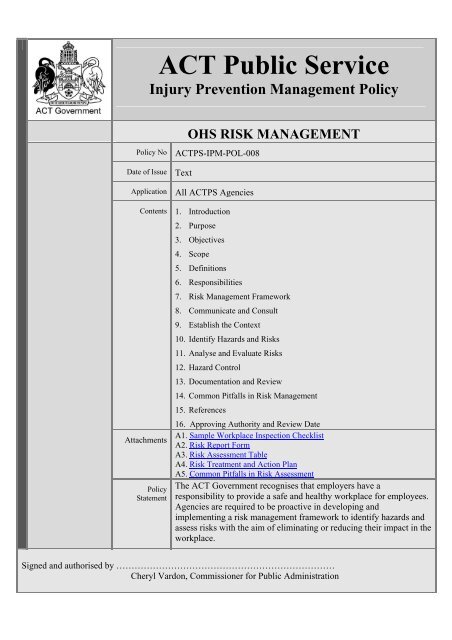
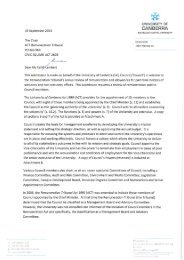
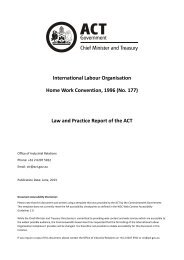
![HSR Training Programs Guidelines [ PDF 191KB]](https://img.yumpu.com/51348280/1/190x245/hsr-training-programs-guidelines-pdf-191kb.jpg?quality=85)


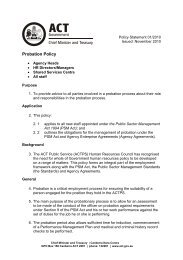

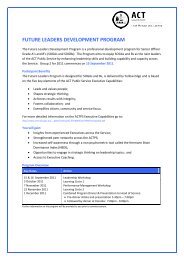
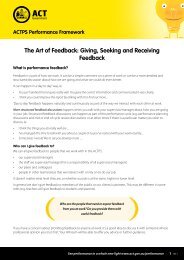
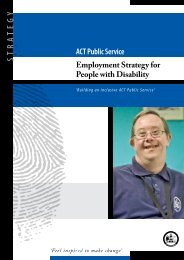
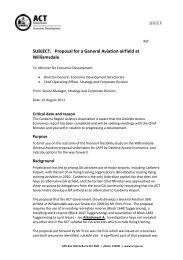
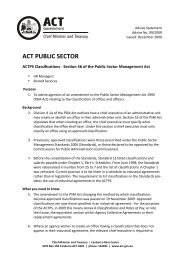
![Teachers Technical and Further Education [ PDF 68KB]](https://img.yumpu.com/34230751/1/184x260/teachers-technical-and-further-education-pdf-68kb.jpg?quality=85)
